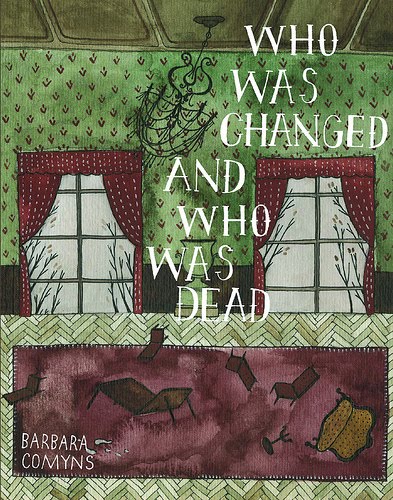Barbara Comyns and Vladimir Sorokin have little in common besides a disturbingly comfortable acquaintance with the grotesque, but I have a review of each of them out in the new Quarterly Conversation. The Comyns book is a masterpiece and although I found it difficult to write about her because of her singular nature, I hope people will be encouraged to read her. Hannah Stoneham has much more on Comyns. As for Sorokin, the best introduction to his work is probably the movie he scripted: 4 (Chetyre).
(Special thanks to Ray Davis for introducing me to Comyns many years ago. Your efforts have not been in vain!)
Who Was Changed and Who Was Dead, by Barbara Comyns
Recently reissued by the press Dorothy, Who Was Changed and Who Was Dead is Comyns’ third novel (more or less; she had previously started a fourth novel, The Vet’s Daughter, but would not finish it until a few years after) and her first instance of actively engaging narrative traditions. Her first novel, Sisters by a River, is an unfathomably strange set of autobiographical scenes from her childhood, alternately pastoral and horrific, yet with little change in narrative tone between the two moods. The second novel, Our Spoons Came from Woolworths, is an autobiographical chronicle of her pained first marriage. The material is far more normal, but the voice, half-detached from the world, a bit maladapted, and yet absolutely certain of itself, is clearly the same.
That voice persists in the omniscient third-person in Who Was Changed, which was does not rely on biographical details and yet proceeds with exactly the same confidence. With utter smoothness, Comyns blends jarring and sudden narrative twists into what seems to be a naturalistic novel. Looking back after reading, the amount of time events seem to take is wholly at odds with the number of pages they occupy, in one direction or the other. Digressions and seemingly awkward phrases seamlessly fold into whole.
The plot itself is simple. In a small English village, Warwickshire, sometime in the 19th century, still water causes a case of ergot poisoning in some loafs of bread, and those who eat the bread change, die, or both.
Vladimir Sorokin: Meat and Clones
At first glance, Vladimir Sorokin may seem like nothing but a stylistic provocateur. I first heard of him in connection with Blue Lard, an as yet untranslated novel about clones that produce the titular lard (salo) as a byproduct of writing, which is then used for fuel. Salo is associated with an ethic stereotype of the Ukraine, mocked by Russians, while “blue” (голубой) is slang for “homosexual.” The book caused a stir because of passages like this:
Khrushchev unbuttoned his own pants and took out his long, uneven penis with its bumpy head, its shiny skin tattooed with a pentacle. The count spat in his palm, lubricated Stalin’s anus with his saliva, and, falling upon him from behind, started to thrust his penis softly into the leader. (tr. Lisa Zigel)
Sorokin’s agenda is clear: the demolition of sacred icons (Putin has endorsed a general movement to reestablish Stalin as the leader of a Russian golden age), blatant attempts to provoke, unerotic sexuality and an emphasis on the grotesque aspects of the flesh, and an hostile, inhuman view of the future. With Blue Lard the provocation was successful: the book was prosecuted as pornographic (the charges were dropped) and ceremonially tossed into a giant toilet by the pro-Putin youth movement Walking Together.
There is far more going on under the obscene, visceral surfaces of his books than the controversy would suggest, and his work has an urgency and gravity lacking in the more self-amused fictions of Tatyana Tolstaya and Victor Pelevin.


17 June 2011 at 09:48
OK SPOILERS:
Anyone want to venture a guess at exactly WHAT happened in the end of 23,000? So their whole plan didn’t work? In which case what was the ice? Whose plan was it? What’s the significance of Bjorn wanting to “talk to God”? How does this impact the way we look back on the previous 700 pages? Thoughts?